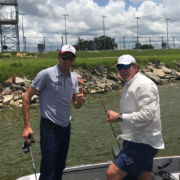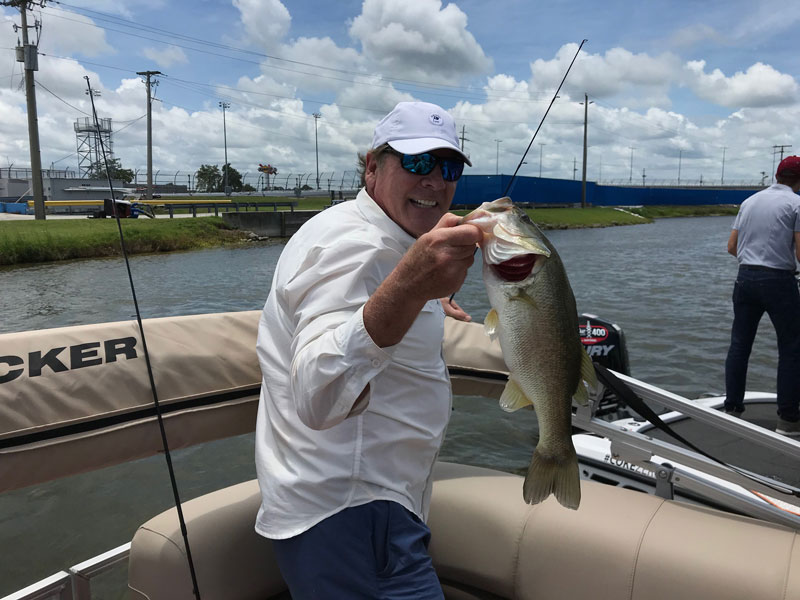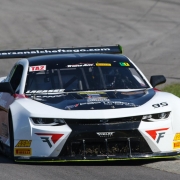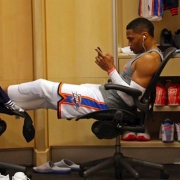NASCAR and Fitness? Jimmie Johnson Changed That
A few years ago my friend, racecar driver Scott Lagasse, Jr. from St. Augustine invited me to come along on his Champions Ride for Bicycle Safety, I like riding my bike, and although I was coming off knee surgery, I joined in with some of Scott’s high-profile friends from the racing community to try and help “humanize” the relationship between cyclists and cars on the road.
One of the fun things about the ride was a lap around Daytona International Speedway and a finish in Victory Lane. Fifty-five miles in, we made the final turn south; the track loomed in the distance. That means the guys in the front of the peloton of about sixty riders kicked it up a notch.
They left me behind. In bike language, they “dropped” me.
That’s when I felt a hand in the middle of my back and the rider next to me said, “Hey buddy, we’ve all been there, let’s go.” I recognized 7-time NASCAR Champion Jimmie Johnson’s voice immediately. I looked at him and I’m sure I said something incoherent. When I glanced at my computer, I noticed we were already doing 28 mph. Jimmy Johnson was pushing me, riding one-handed doing 28!
“Let’s go get them,” I said as Johnson shoved me up to the back of the pack. It was my first hint at Jimmie Johnson’s level of fitness.
Lagasse and his friends ride the “Champions Ride” every year during Speedweeks in Daytona to help raise the profile of bike and vehicle safety. Anybody who’s been riding has had an unpleasant “interaction” with a vehicle.
That includes Scott and even Jimmie Johnson. Johnson will start on the outside of Row Three in today’s Daytona 500 looking for his third victory in “The Great American Race.” He announced earlier this year that 2020 would be his final year driving full-time on the NASCAR circuit,
Jimmie has been part of the Champions Ride since the beginning. He rides or runs at each stop on the NASCAR schedule and when he’s home in Charlotte. Being in a sport where safety is part of the rules, Johnson knows safety between cars and riders is paramount.
“Safety is everything,” Johnson told me at a rest stop during this year’s ride last Thursday morning. “I think it’s the responsibility of the cyclist and the motorists to find some common ground there. That’s the key.”
Jimmie is dedicated to fitness. He ran in the Daytona Half-Marathon last weekend before the Busch Clash. “The Half turned out better than the Clash,” he joked.
In his home base of Charlotte, Johnson has started numerous fitness initiatives. He’s shared his passion with everybody.
“I’ve enjoyed my journey and I wanted to share it with my friends. I’m impressed with the community of running and cycling and triathlons,” Johnson said.
Promoting small lifestyle changes among his crew and other crewmembers in the garage, Johnson has changed a lot of the perception of fitness in racing.
“Jimmie has changed the sport in that aspect,” said Lagasse, who will drive and field two teams full-time on the Trans Am circuit this year. “Guys used to think it showed weakness. Now team owners demand it. The drivers are training harder than they’ve ever trained. Crew chiefs pay attention to it. Even kids coming up now have trainers.”
Lagasse says he used to be a basketball player and used the sport to stay in shape. About ten years ago he started riding thanks to his father, Scott Sr.
“It’s something we can do together and be competitive,” Scott said of riding with his dad, who turns sixty-one this week. Scott Sr. is a two time Sports Car Club of America National Champion who still rides. “That’s probably where some of my passion comes from. He’s a machine.”
Cars and bikes don’t mix well on the roads in Jacksonville and North Florida. There’s not enough room. Despite the vast size of our community, there are very few bike lanes. It hasn’t been part of the plan. Neither group seems to have a good grasp of the laws that govern the road. That creates tension instantly.
That’s where the State of Florida’s Alert Today, Alive Tomorrow comes in. They’re a state agency that is solely dedicated to car, bike and pedestrian safety. .
“They work tirelessly to raise the awareness that both cyclists and motorists need about how to share the road,” Lagasse said before this year’s Champions Ride. “Both groups have a shared responsibility. Alert Today, Alive Tomorrow’s mission is safety.”
This year’s ride was in honor of Volusia County Sheriff’s Deputy Frank Scofield who was killed in a bike accident just outside of Daytona last June. Lagasse had ridden with Scofield in the past and credits him with the large law enforcement support the ride has year after year.
“Frank had a lot to do with the success of this ride,” Lagasse said as he presented a signed cycling jersey to Scofeld’s widow. “We’re riding his training route today.”
Despite their sponsorship agreement ending, Lagasse says he’s staying involved with the state agency to help get the word out.
“They’re emailing me at midnight to ask if I’ll be a part of an event. They’re working all times of day because they believe in what they’re doing,” Scott explained. “It motivates me to want to do more.”








